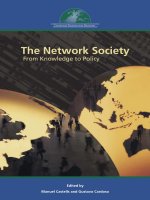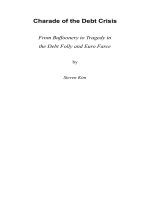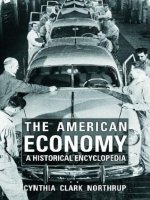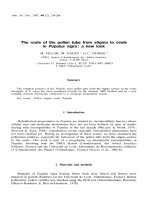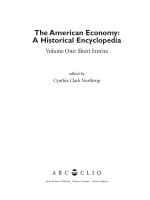The american economy from roosevelt to trump
Bạn đang xem bản rút gọn của tài liệu. Xem và tải ngay bản đầy đủ của tài liệu tại đây (3.36 MB, 180 trang )
VittorioValli
TheAmericanEconomyfromRoosevelttoTrump
VittorioValli
DepartmentofEconomicsandStatistics“CognettiDeMartiis”,UniversityofTorino,Torino,
Italy
ISBN978-3-319-96952-7
e-ISBN978-3-319-96953-4
/>LibraryofCongressControlNumber:2018954741
©TheEditor(s)(ifapplicable)andTheAuthor(s)2018
Thisworkissubjecttocopyright.Allrightsaresolelyandexclusivelylicensedbythe
Publisher,whetherthewholeorpartofthematerialisconcerned,specificallytherightsof
translation,reprinting,reuseofillustrations,recitation,broadcasting,reproductionon
microfilmsorinanyotherphysicalway,andtransmissionorinformationstorageand
retrieval,electronicadaptation,computersoftware,orbysimilarordissimilarmethodology
nowknownorhereafterdeveloped.
Theuseofgeneraldescriptivenames,registerednames,trademarks,servicemarks,etc.in
thispublicationdoesnotimply,evenintheabsenceofaspecificstatement,thatsuchnames
areexemptfromtherelevantprotectivelawsandregulationsandthereforefreeforgeneral
use.
Thepublisher,theauthorsandtheeditorsaresafetoassumethattheadviceandinformation
inthisbookarebelievedtobetrueandaccurateatthedateofpublication.Neitherthe
publishernortheauthorsortheeditorsgiveawarranty,expressorimplied,withrespectto
thematerialcontainedhereinorforanyerrorsoromissionsthatmayhavebeenmade.The
publisherremainsneutralwithregardtojurisdictionalclaimsinpublishedmapsand
institutionalaffiliations.
Coverillustration:Jupiterimages/Getty
ThisPalgraveMacmillanimprintispublishedbytheregisteredcompanySpringerNature
SwitzerlandAG
Theregisteredcompanyaddressis:Gewerbestrasse11,6330Cham,Switzerland
Preface
In1978,IpublishedabookontheUSeconomicsystem.Aftermorethan30years,Ireturned
towriteaboutthelargestandmostpowerfuleconomyintheworldandonitseconomicand
politicalrelationsinaverydifferent,butequallyimportant,historicalphase.Thefirstedition
ofthisbookwaspublishedbyCarocciin2010.ItwaswritteninItalianandhadaconsiderable
successintherelativelyrestrictedItalianmarket.
ThisEnglisheditionofthevolumeisnotonlyafullyrevisedandupdatedversionofthe
bookbutanewedition.Itaddstwoimportantchapters.Chapter5isdevotedtotechnical
progressandtothestrongaccumulationofphysicalcapitalandknowledge,whichhavebeen
adistinctivefeatureofAmericaneconomicsuccessforoveracentury.Theothernewchapter
isdedicatedtotheeconomicconsequencesofDonaldTrumpinthefirst18monthsofhis
presidency.AlsoObama’spresidencyandthecriticalmatterofthedeclineoftheAmerican
economyhavebeenmorefullyanalyzed.
Aremarkmustbemade:theRooseveltinthetitleisnotFranklinDelano,butTheodore
Roosevelt,sincemybooktakesessentiallythemovefromthebeginningofthetwentieth
century.
Ihavenotwrittenathoroughanddetailedeconomichistory,butIhavetriedtogivean
interpretationofthemainlong-termeconomictrendsinthecountryfrom1870uptonow.I
didnotdosoasaneconomichistorian,butasamacroeconomist,focusingonlyonthemain
changesandsomecrucialturningpointsoftheeconomyoftheUS.
Theinterpretativeline,theredthreadofthebook,isthefollowing.
Intheperiod1870–1913,theUShadanimpressiveeconomicdevelopmentandamuch
fasterrateofgrowththanmostothercountries,becomingthemajoreconomyintheworld.
Thishadbeenlargelyduetothegreatadvantageofthefrontier,thatis,thepossibilityto
movewestusinguntappednaturalresources,newlandstocultivate,newpastures,new
mines,andsoon.Thisfavoredlargeimmigrationinflowsandbothextensiveandintensive
investment,technologicalprogress,andeconomiesofscale,facilitatingtherapidgrowthof
theeconomy.
Intheearlytwentiethcentury,thesebenefitsgraduallyweakened.TheUS,however,could
successfullycontinueitsrapideconomicascentbecause,since1908,ithadgraduallyreplaced
thosebenefitswiththeonesderivedbytheFordistmodelofdevelopment.
DespitethegreatdepressionundergonebytheUSeconomyaftertheWallStreetcrashof
1929andthroughoutthelostdecade1929–1939—whentheFordistmodelworked
backwards—theFordistmodelcouldbepartiallyreactivatedaftertheconclusionofthe
SecondWorldWar.
Sincethe1950s,thedominatingUSeconomyhadbeenslowlylosinggroundbecauseof
theoutbreakofsomecreeping,deepweaknessesintheAmericandevelopmentmechanism
andintheFordistmodelitself.TheUShadgraduallybecomealargenetimporterofenergy
andwasgrowingataslowerpacethanseveralWesternandEasternEuropeaneconomies,the
SovietUnion,Japan,andthefourAsiantigers.ThisledtheUStotryanothersolution,namely,
theattemptatgraduallybuildingupaglobaleconomicempire.SinceBrettonWoods,theUS
hadstronglypushedtowardstheestablishmentofthedollarasthekeycurrencyofthe
internationalmonetarysystem;ithadmadeahugemassofforeigndirectinvestment;ithad
favoredagradualprocessofliberalizationoftheinternationalmovementsofgoodsand
capitals,sustainingfromtheearly1970sagrowingeconomicandfinancialglobalization;it
hadtakenpartinmajorwarsinKorea,Vietnam,andtheMiddleEast.Thedominancein
finance,technology,andtheinterneteconomy,accompaniedbyanextensivepoliticaland
militarypower,couldtemporarilyrelievetheUSfearsthatglobalizationcould,inthelongrun,
destabilizetheverysourcesofitseconomichegemony.ThecrisisoftheSovietUnionandof
theSovietblocinthelate1980sandthebeginningofthe1990sseemedtopromisethefull
achievementoftheAmericanaimsandtomarktheendofhistory,withthefinalprevalenceof
westernliberaldemocracy.
Buthistoryteachesusthathistoryneverends:ithasalwaystrendsandcycles,reversalsof
fortune,suddenupheavals,gradualascentsordecline.
Unregulatedglobalizationandtechnologicalchangesfinallyledtoagreatbacklash.The
rapidindustrializationandtechnologicalcatchingupofJapan,SouthKorea,andthenChina
andotheremergingcountriescontributedtoacceleratetheUSdeindustrializationand
indirectlyincreaseUSeconomicinequalities.Wehave,moreover,witnessedthepassageof
partofEasternEuropetotheEUafterthedissolutionoftheSovietUnion;thebooming
expansionoftheChineseeconomyand,since1992,thatofIndia;thegrowingtensionsinthe
MiddleEast;theattackonthetwintowersonSeptember11,2001;thewarsinAfghanistan,
Iraq,Syria,andLibya;theadventandsemi-defeatofISIS;thedesireforresurgenceofRussia
andofemergingpowers;thegreatrecession;thedramaofmigrantsandrefugeesfromLatin
America,MiddleEast,andAfrica;theBrexit,andsoon.
Thereactiontoapartoftheseeventshasbeenthebrutalrecoursetoarmsandwarsofthe
twoBushadministrations,themorenuanced,butundecided,Obama’sinternationalpolicy
andtheroughavowalofAmericafirstandofprotectionistmeasuresofTrump’spopulist
policy.Allthisisleadingtowardsanimperfectmultipolarworld,muchmoredifficultand
complexthantheasymmetricbi-polarismprevailinginthe1946–1989years,frozenbythe
hardequilibriumofcoldwarandnuclearterror.AphaseofgradualdeclineoftheAmerican
economicpowerhadtakenitsfirststeps.
Ineconomicmatters,thegreatrecessionofthe2007–2010yearshasprovedtheinner
fragilityofaneconomydominatedbybanksandmultinationalsandinwhichthepolitical
decisionsareheavilyinfluencedbytheinterestsofthebigfinance,thebige-corporations,the
multinationals,andthesuper-rich.
IntheUS,PresidentObamasavedthemajorityoffinancialinstitutionsandsomebig
industrialcorporationsandhelpedtherecoveryofthecountrybystimuluspackages.Hetried
alsotoputsometimidlimitstotheunrulyactionofmajorfinancialgroupsandtoextendthe
healthcoveragetothemajorityofthepopulation.Finally,hetriedtotakesomestepstoward
a“green”policy,butatthesametime,hefavoredtheexpansionoffrackingtechniquesinthe
extractionofoilandgas,whichreducedtheUSenergydependencebutcausedsevere
environmentaldamageinvastzonesoftheterritory.Obama’smajordomesticfailureisdue
tohistimidreformistandgradualistapproach,whichcouldattenuate,butnotarrest,the
continuingriseofthegreatfracturesintheUSeconomyandsociety:therapidlyincreasing
dividebetweentherich,thepoor,andthedecliningmiddleclass,betweenracesandreligions,
betweenimmigrantsandnatives.Thesefractureshaveindeedbeentheculturemediumof
DonaldTrump’spopulistappeal.
PresidentTrumphasannouncedandthentriedtocancel,orreduce,theeffectsofObama’s
policiesonhealthandongreenpolicies.Healsoproceededtoextendanti-migrationwalls,to
repudiatesomemultilateraltradeagreementsandtoraisesometariffs,totryreducingoffshoringandattractforeigninvestment.Hefinallycuttaxation,inparticulartocorporations
andtorichpeopleashimself.Hispopulistpolicyhashelpedhimtogainthepresidential
election,buthiscontroversialpersonality,fullofhaughtinessandofracistandsexist
elements,andhisintricatelinkswiththeinterestsofthearmindustry,theoilandcoal
corporations,theconstructionindustry,andbigfinance,canpreludetoevengreatersocial
fractures,totradewars,andtoadangeroussceneryininternationalrelationsandinthe
socialandenvironmentalarenas.
VittorioValli
Torino,Italy
Acknowledgments
DuringmanyyearsofworkontheAmericanEconomyandoncomparativeeconomic
development,Ihaveaccumulatedmanyintellectualdebts.ThefirstoneistowardHarvey
Leibenstein,HollisB.Chenery,GregoryGrossman,andCarloMariaCipolla.Ioriginallymet
theminBerkeleyin1966–1967andthenonseveralotheroccasions.Thefirstthreescholars
gavemeatastefortheanalysisoftheproblemsofeconomicdevelopmentandofcomparative
studies;thefourth,agreateconomichistorian,thepleasureofcombiningeconomicsand
history.AnotherimportantdebtistowardAngusMaddisonandseveralItalianeconomists,in
particularPaoloSylosLabini.OfAngusMaddison,Iappreciatednotonlytheimpressivework
ofreconstructionandanalysisofmacro-economicdata,widelyusedinthisbook,butalsothe
vastknowledge,clarity,andconcisioninwriting.OfSylosLabini,Igreatlyappreciatedhis
exceptionalcapacityofskillfullycombiningeconomictheorywithsocialfactsandhisrelevant
policyinsightandgenerouscivilcommitment.Adebtisalsoduetofriendsandcolleagues
whoreadorreviewedtheItalianortheEnglisheditionsofthebookandgavemehelpful
commentsandsuggestions,andinparticular,NicolaAcocella,GiovanniBalcet,GianCarlo
Bisacchi,TerenzioCozzi,SilvanaDalmazzone,EnricoFilippi,DinoMartellato,Ferdinando
Fasce,AngusMaddison,IgnazioMusu,GiulianoPetrovich,SanjayReddy,SalvatoreRossi,
MarcelloSignorelli,RenataTargettiLenti,PierangeloMariaToninelli,GianniToniolo,and
MaurizioVaudagna.ParticularthanksareduetoLuigiOddo,whohasskillfullyprovidedthe
updatingofmostfiguresandtablesfortheEnglisheditionofthevolume.
IfinallythanktheeditorsofthepublisherCaroccifortheirimportantcontributiontothe
ItalianeditionofthebookandLauraPaceyandClaraHeathcockofPalgraveMacmillanfor
theirverykindandcompetentsupervisionofthenewEnglisheditionofthebook.
Anyerrorsoromissionsare,ofcourse,mycompleteresponsibility.
Contents
1TheBirthofaGreatEconomicPower
1.1TheEconomicAscentoftheUS
1.2TheEconomicConsequencesoftheFrontier
References
2TheFordistModelofEconomicDevelopment
2.1TheConceptofFordism
2.2TheFordistModelofEconomicDevelopment
References
3TheGreatDepressionandtheNewDeal
3.1TheWallStreetCrash
3.2TheGreatDepression
3.3TheNewDeal
3.4TheDebateontheGreatDepressionandtheNewDeal
References
4ReturnandCrisisoftheFordistModelofDevelopment
4.1TheWarandItsConsequences
4.2TheReturntotheFordistModel:1946–1969
4.3TheCrisisoftheSecondWaveoftheFordistModel
References
5CapitalAccumulation,TechnologicalProgress,andKnowledge
5.1TheMainDeterminantsofEconomicDevelopment
5.2CapitalAccumulation
5.3TheRoleofTechnologicalProgress
5.4TheImportanceofKnowledge
5.5StructuralChangesintheUSEconomy
5.6RobotsandtheE-Economy
5.7SummingUp
References
6TheGlobalPoweroftheUS
6.1AfterTeheranandYalta
6.2TheMainPointsofStrengthoftheUSEconomy
6.3TheEconomicConsequencesoftheWars
6.4Economic,Military,andPoliticalPowers
6.5TheUSandtheTurinIndexofEconomicPower
References
7MainWeaknessesintheAmericanEconomicPower
7.1TheDependenceonForeignOilandOtherRawMaterials
7.2TheEnvironmentalProblemintheUS
7.3PhasesofAscentandDeclineoftheUSEconomy
7.4FromSurplustoStructuralDeficitintheUSBalanceofCurrentAccounts
7.5TheWeakeningoftheDollar
7.6RisingInequalitiesinWages,Income,andWealth
7.7TerrorismandOrganizedCrime
7.8TheWitheringoftheAmericanDream
7.9TheErosionofDemocracy
References
8TowardaGlobalEconomicEmpire
8.1TheInstruments
8.2Post-warAidsandtheMarshallPlan
8.3ThePathtowardTradeLiberalization
8.4ForeignDirectInvestmentandtheGrowthoftheUSPresenceintheWorld
8.5TheUSandtheThirdWaveofEconomicandFinancialGlobalization
8.6TheFinancialSupremacy
8.7IdeologyandtheAmericanLifestyle
8.8TheInfluenceofMediaandInternet
8.9ThePowerofArmsandDiplomacy
References
9TheGreatRecession
9.1WhytheGreatFinancialCrises?
9.2TheUSSub-primeFinancialCrisis
9.3TheGreatRecession
9.4TheInadequacyofControls
9.5PossibleRemedies
9.6AComparisonwiththeGreatDepression
References
10Obanomics
10.1Obama’sIdeasonEconomics
10.2Obama’sResponsetotheGreatRecession
10.3TheIndustrialandInnovationPolicy
10.4ObamaandtheEnvironment
10.5Obamacare
10.6Inequality,Taxation,andtheMiddle-ClassCrunch
References
11TheEconomicConsequencesofDonaldTrump
11.1PopulismandTrumpism
11.2DonaldTrump’sVictoryinthe2016PresidentialElection
11.3TheRelationswithEconomicandFinancialPower
11.4AmericaFirst
11.5TheNeo-ProtectionistPolicy
11.6TheReformTaxBill
11.7Trump’sPolicyonHealthCareandEnvironment
References
12America’sDecline?TowardanImperfectMultipolarWorld
12.1America’sDecline?
12.2China:TheOtherEconomicGiant
12.3TheRoleoftheEuropeanUnion
12.4Russia,Japan,India,andOtherEmergingPowers
12.5TheNongovernmentalPowers
12.6TheFragilityofInternationalOrganizations
12.7Conclusions
References
StatisticalAppendix
Index
ListofFigures
Fig.1.1Theeconomicconsequencesofthefrontier
Fig.2.1TheFordistmodelofdevelopmentintheUS
Fig.3.1ThegreatdepressionintheUS
Fig.3.2Fascistcorporatismversusdemocraticneo-corporatism
Fig.4.1USrealoutputperhourandrealadjustedhourlyearnings:1950–2017
Fig.5.1Thepyramidofeconomicdevelopment
Fig.6.1Economic,political,andmilitarypowers
Fig.7.1USoildependencefromabroad:1949–2017
Fig.7.2BalanceofcurrentaccountsintheUSeconomyinpercentofGDP:1960–2016
Fig.7.3USdollarratesofexchange:1968–2017
Fig.7.4Theerosionofdemocracy
Fig.8.1USexportsandimportsofgoodsandservicesintheUS:1950–2016
Fig.8.2USoutwardandinwardFDIstocksinselectedyears:1980–2016
Fig.9.1RealGNPinthegreatdepressionandinthegreatrecession
Fig.10.1EcologicalFootprintandBio-capacityintheUS:1961–2014
Fig.12.1TotalGDPinChina,Russia,andIndia:1978–2017
Fig.12.2Theeconomicascentofselectedemergingcountries:1978–2017
ListofTables
Table1.1PopulationintheUSandotherselectedcountries:1820–1913
Table3.1IndicatorsonthegreatdepressionintheUS
Table4.1RatesofchangeofGDPandpercapitaGDPinselectedeconomies:1950–1973
Table4.2Mainreasonsfortherapidgrowthofselectedeconomiesintheyears:1950–1973
Table5.1KnowledgeindicatorsintheUSandotherselectedcountries
Table5.2EmploymentbysectorofeconomicactivityintheUS(%):1870–2017
Table6.1Population,GDP,andpercapitaGDPintheUS,SovietUnionandRussia:1950–1991
Table6.2Selectedinternalindicatorsinselectedcountries
Table6.3Exports,stockofoutwardFDI,andpersonsemployedinR&D
Table6.4TheTIEP:1952,2008,and2017
Table7.1PhasesofascentanddeclineoftheUSeconomy:1870–2017
Table8.1Selectedindicatorsoneconomicglobalization:1980–2016
Table8.2SelectedindicatorsoftheUSinthethirdglobalizationwave
Table9.1ThegreatrecessionintheUSandinselectedEUcountries
Table9.2RealGDPandrealpercapitaGDPinthetwoUSgreatcrises
Table9.3Acomparisonbetweenthegreatdepressionandthegreatrecession
Table10.1Annual%rateofchangeofrealGDPinselectedareasorcountries:2007–2017
Table10.2Harmonized%unemploymentratesinselectedareasorcountries:2007–2017
Table10.3Federalreceipts,outlays,deficits,anddebtaspercentofGDP:2007–2019
Table12.1TheUSandChina:selectedindicators
TableA1PopulationintheUSandintheselectedcountries(million)
TableA2TotalGDPinPPP,notadjustedtoICTprices,intheUSandinselectedcountries
(US=100)
TableA3GDPper-capitainPPP,notadjustedtoICTprices,intheUSandinselectedcountries
(US=100)
TableA4MacroeconomicindicatorsintheUSandinselectedcountries:1952–2017
TableA5MacroeconomicindicatorsfortheUSintheperiod1980–2017
TableA6OtherindicatorsfortheUSintheperiod1980–2017
TableA7Full-timeandpart-timeemployeesbyindustryintheUS:1950–2017
©TheAuthor(s)2018
VittorioValli,TheAmericanEconomyfromRoosevelttoTrump
/>
1.TheBirthofaGreatEconomicPower
VittorioValli1
(1) DepartmentofEconomicsandStatistics“CognettiDeMartiis”,UniversityofTorino,
Torino,Italy
VittorioValli
Keywords TheAmericaneconomy–TheeconomyoftheUSinthe1870–1908period–The
frontierintheUSeconomy–TheeconomicascentoftheAmericaneconomy
1.1 TheEconomicAscentoftheUS
Inthelastdecadesofthenineteenthcentury,theUShadbecomethemaineconomicpowerin
theworld.AccordingtoMaddison’sestimatesoftotalGrossDomesticProduct(GDP)in
purchasingpowerparities(PPP),in1872theUSsurpassedthemainindustrialpowerofthose
years,theUK.1ThenitsurpassedtwopoorerbutmuchmorepopulouscountriessuchasIndia
andChinain1876andaround1886respectively,becomingthecountrywiththelargesttotal
GDPintheworld.
Whilein1870,China,India,andtheUKhadatotalGDPinPPPlargerthantheUSby93%,
37%,and18%,respectively;in1913,thesituationhadradicallychanged:theUShadatotal
GDPinPPPs2.1timeslargerthanChina,2.3timeslargerthantheUK,2.5timeslargerthan
India.2
Intheyears1870–1913,theUShadaccomplishedagreatrelativeeconomicascent.With
thisconceptImeanaprolongedperiod(twodecadesatleast),inwhichtherateofgrowthof
theeconomy,measuredbytheaverageannualrateofchangeofpercapitaGDP,is
significantlyhigherthantheworldrateofgrowth.Inthoseyears,thepercentannualrateof
changeofpercapitaGDPoftheUShadinfactbeen1.82,whiletheworldaveragehadbeen
1.3.3Thelastquarterofthenineteenthcenturyandthefirstyearsofthetwentiethcentury
sawtheformationoftheUSeconomicdominance,whichclearlymanifesteditselfinthe
followingyears.
Inthatperiod,theperceptionofsuchaprofoundchangeintheworldeconomicequilibria
was,however,verylimited.Inthosedays,therewerenosyntheticeconomicindicators,such
asGDP,anditwasthereforeverydifficulttoperceiveandcorrectlyassesstheimportanceof
worldeconomictransformations.Moreover,thegreatWesternEuropeanpowers,theUK,
France,andGermanyhadavastcolonialempire,sotheireconomicstrengthwasaugmented
bytheimportanteconomicandfinanciallinkswiththeircolonies.
Therewas,moreover,aremarkableignoranceofwhatwashappeningoutoftheirnational
boundariesoroutoftheirempireseveninsomeoftheprominentpoliticalleaders.Education
atschoolwasthen,asitistoday,stronglynationalistic,andinEurope,euro-centric,butits
effectswerenotattenuated,asitnowhappens,byextensivetravellingabroad,themassive
diffusionofinternationalmediaandthewidespreaduseofinternet.
Inanycase,thecolonialempires,thoughvastandpowerful,weregiantswithclayfeet.
Theyweredestined,inthelongrun,todissolve,asithappenedinthree-fourdecadesafterthe
SecondWorldWar.Theywere,infact,underminedbyfourintrinsicweaknesses.
Fromtheeconomicpointofview,theEuropeanempiresweresubstantiallybasedonthe
principlecenter-periphery.Therapidgrowthofindustryandofmoderntertiaryactivities,and
soafastereconomicgrowth,wasmainlyconcentratedinthecenteroftheempire,whilethe
periphery(thecolonies)actedmainlyasfurnishersofrawmaterialsandasamarketfor
manufacturedgoods.Itfollowsthattherewasaveryunequaleconomicgrowthinthecenter
andintheperipheryofsuchempiresandthereforelargeandgrowingtensionstowardsa
socialandeconomicresurgenceofcolonies.
Withincolonialempires,therewere,moreover,greatethnic,linguistic,andreligious
differences,whichinthelong-runcontributedtounderminetheirexistence.
Themarkeddifferenceincitizenshipstatusamongtheinhabitantsofthecenterandofthe
peripheryoftheempirescontributedtoinducethediscriminatedordisadvantagedpeopleof
thecoloniestorebellionandtoafiercesearchforindependence.
Finally,therewasastrongterritorialdiscontinuitywhichmadethemovementsofarmies
andsecurityforcesinalltheempire’szonesdifficult,costly,andtime-consuming.Itisnotby
chancethatinafewdecadesaftertheSecondWorldWarallcolonialempiresdissolvedwhile
theUS,China,India,andRussia,whichhadafullorquasi-completeterritorialcontinuity,
couldsurvive,althoughsince1947IndiahadsufferedfromthedramaticIndia-Pakistan
partition,andin1991therehadbeenthedissolutionoftheSovietUnion.
TheprodigiouseconomicascentoftheUSintheyears1870–1913ismainlyduetothree
elements:
1.
2.
Theconsequentrapidexpansionofpopulationandoftechnicalprogress,andthereforeof
Theexistenceofthefrontieruntilthebeginningofthetwentiethcentury
realproductivityandrealGDP
3.
Theactivation,whentheadvantagesofthefrontierbegantograduallyshrink,ofthe
fordistmodelofdevelopmentthatcontributedtoprolongthepossibilityoftherapid
economicgrowthoftheUSeconomy
1.2 TheEconomicConsequencesoftheFrontier
Afterreachingindependence,andinparticularduringthenineteenthcentury,theUSfully
utilizedacrucialandpeculiargrowthdeterminant:thefrontier,namely,thepossibilityto
movewesttoexploitnewnaturalresources.4
Inthewest,therewereabundantarablelands,pastures,minesforgoldandother
importantminerals,coalandoilfields,forests,waterresources,buffaloes,furs,fish-richlakes,
rivers,andtheocean.
TheexistenceofthefrontierhadpermittedtheUStodisposeofenoughfoodandnational
resourcestobeabletorapidlyexpanditspopulation.TherapidgrowthoftheUSpopulation
wasduetotheacquisitionofvast,newterritories,oftenatthecostoftheexterminationofa
largepartofthepreexistingindigenoustribes,andtothepositivedemographicnaturalrate
andtothecontinuouslargenetinflowofimmigrants.
WhileevenintherichestEuropeancountries,suchastheUKandFrance,thepopulation
wasgrowingveryslowly,intheUSitwasgrowingveryfast.AswecanseeinTable1.1,in1820
thetotalUSpopulationwaslessthanhalfoftheUKpopulationandlessthanonethirdof
France’s,butin1870ithadalreadysurpassedthelevelofthetwogreatEuropeanpowers,and
in1913,ithadmorethandoubled.
Table1.1 PopulationintheUSandotherselectedcountries:1820–1913(inmillions)a
Years France Germany UK Italy US
1820 31.3
24.9
21.2 20.2b 10.0
1870 38.4
39.2
31.4 27.9
40.2
1913 41.5
65.0
45.6 37.2
97.6
Source:Maddison(2003),pp.36–37,81–82
aWiththepresentborders
bBeforeunification,butassumingthepresentborders
Therapidexpansionofthepopulationcontributedtoanincreaseinthedemandforgoods
andservices,stimulatingamassiveriseintheinvestmentofenterprisesandofpublicand
privateinvestmentininfrastructures,suchasrailways,roads,ports,schools,andhospitals.
Theexistenceofthefrontieralsoledtoastrongtechnologicalprogress,asitisshownin
Fig.1.1.ThemerepossibilityforspecializedworkersintheeasterncoastorinChicagoto
movetotheWestincreased,ceterisparibus,thecontractualstrengthofskilledworkersvis-àvistheirentrepreneurs,andthereforethepossibilityofobtainingwagerises.
Fig.1.1 Theeconomicconsequencesofthefrontier
Source:Ourelaboration
This,togetherwiththepressureoftheascendinglaborunionsinthelastdecadesofthe
nineteenthcentury,pushedtheenterprisestoinnovateandinvestmoreinnewlabor-saving
machinesandinmodernplantsinordertobeabletoincreaselaborproductivityandto
maintainacceptableprofitmargins.Theseformsofintensiveinvestmentgenerallyembodied
newtechnologies,thereforeleadingtoageneralriseintheleveloftechnologicalprogressand
oflaborproductivity.
Inordertoattenuatetheriseinwages,therewasalsothegrowingrecoursetoalarge
massofimmigrants,madepossiblebytheexistenceofthefrontier.Butatthesametime,the
frontierinducedalsotomakeextensiveinvestmentaimedatincreasingproductivecapacity
andemployment.Theriseinpopulationandconsumptionrequiredinfactnewrailwaylines,
newroads,bridges,houses,andshops.Itwasnecessarytosupplynew-bornandimmigrants
withfood,clothes,andothergoodsandservices.Allthiscontributedtoraiseinvestment,
production,andemployment.Theriseinunitwagesandinemploymentledtoarapid
increaseintotalwagesandthereforetheconsumption,andthisinducedtomakefurther
extensiveinvestmentinordertoadaptthelevelofproductiontothecontinuousrisein
demand.Theriseinproductivecapacityled,incertainsectors,tolarge-scaleeconomies,
whichcontributedtoincreaseinproductivityandthereforeinternationalcompetitiveness.
Exportsgrewandtheirrevenuescontributedtofinanceimportsandtosustainthevalueof
theUSdollar.Theeconomiesofscalealsofavored,incertainsectors,economicconcentration,
andthustheconstitutionofverylargecorporations.Thepresenceoflargenumbersof
workersinthevastplantsofthemajorcorporationsfavored,ontheotherhand,thebirthofa
countervailingpower,5namely,theconstitutionofpowerfullaborunionsandofliberalor
leftistpoliticalparties.Themassiveriseofbothintensiveandextensiveinvestmentledtoa
rapidgrowthofGDP,percapitaGDP,andlaborproductivity.TherateofchangeoftotalGDPis
approximatelyequaltothesumoftherateofchangeofpopulationandtherateofchangeof
percapitaGDP.6IntheUS,boththeaddendagrewveryfast,sotheirsumgrewevenmore
rapidly.ThispermittedtheUStoreachandthensurpassandrapidlydistancetheleveloftotal
GDPinPPPoftheothermajorindustrializedcountry,theUK.In1872,theUShadinfact
surpassedtheleveloftotalGDPoftheUK,whichhadbeenthelargestindustrialpoweratthe
time.Aboutthreedecadeslater,in1905,theUSpercapitaGDPcametoexceedthatoftheUK
andthenrapidlyoutdistancedit.TheUSlaborproductivity,measuredbyGDPdividedby
employment,whichin1870was88%ofthatoftheUK,overtookitintheearlytwentieth
centuryandin1913exceededtheUK’slevelbyabout15%.7
In1913,theUSnotonlywasthelargesteconomyintheworld,butalsothemostadvanced
intermsoftheaverageleveloftechnology,percapitaGDP,andlaborproductivity.The
existenceofthefrontier,thelackofafeudalheritage,andotherhistoricalandcultural
elementswerealsoabletoinjectsignificantamountsofdemocracyandfreedominAmerican
societyaswellasaconsiderablesocialmobility.8Whileinthenineteenthcentury,thelatter
workedalmostexclusivelyforwhiteAnglo-Saxonmenandmuchlessforwomen,blacks,
Hispanics,andAmericanIndians,nonetheless,ithadallowedtheemergenceoftheso-called
AmericanDream,theabilityofeachmantobeabletosuccessfullyforgehisfuturecountingon
hisskillsandcommitmenttowork.
However,in1913,theadvantagesofthefrontier,whichwerethehighestinthenineteenth
century,hadlargelyvanished.Mostofthewesternlandshadalreadybeensoldorrented,
manyminesofgoldandothermineralshadalreadybeendiscoveredandexploited,the
buffaloesexterminated,andlargeforestsdestroyed.Anumberofresources,suchaslargeoil
fields,thenonlypartiallydiscoveredandputintoproduction,stillremainedtobeexploited.
Moreover,landsinseveralwesternstatesandtheMidwestwerestilllargelypubliclyowned
andcouldberentedatpricesfarlowerthantheaverageEuropeanprice.Thisallowedto
cultivateonlythemostfertilelandsandtoapplyextensivecultivation,whichwasmore
profitablethantheintensiveoneprevailinginmanypartsofEuropeandAsia,whichwere
muchmoredenselypopulated.
Since1908,however,theUScouldbegintoreplacesomeofthedecliningadvantages
associatedtothefrontier,withthebenefitsarisingfromtheFordistmodelofdevelopment.The
introductionofthismodelcanbetracedbacktotheopeningofthefirstlarge-scale
automotiveplantproducingwithlargeassemblylinesacarmuchcheaperthanprevious
models:thefamousFordModelT.Thismodelwasproducedinover17millionunitsfrom
1908to1927.Itdidcostatthebeginningabout$850,lessthanhalfthepriceofcompeting
models.Thepricefurtherdiminishedovertimeduetoeconomiesofscaleandproduction
improvements,reaching$285forthebasicversionin1926–1927.Cars,whichpreviously
werealuxurygoodforafewrichpeople,becameamass-product,accessibletomiddle-and
upper-middleclasspeopleandeventoagrowingshareofworkersinthecarindustry.This
wasthebeginningoftheFordistphaseofAmericaneconomicdevelopment.Itwassimilarin
someaspectstotheoneprevailinginWesternEuropeandJapanabout40yearslater,inthe
1950sand1960s,andinemergingcountrieslikeChinaintheyears1980sand1990sandin
theearlytwenty-firstcentury.
TheFirstWorldWar,whichtheUSenteredalongsidethealliedforcesagainsttheGerman
andAustriantroops,onlypartiallyinterruptedthefordistphaseintheUS.Thewar,whichled
toalargenumberofcasualtiesandatemporaryreductionofcivilianproductioninsome
areas,had,however,allowedtheUStomoveitsproductiveforceandFordistmethodsof
productionfromtheciviltothemilitarysectorandtotransfersubsequentlysome
technologicalmilitaryadvancementstothecivilsector.Overall,theFirstWorldWar,although
causingabout117,000UScasualties,lefttheUSstrengthenedmilitarily,politically,and
economically,significantlyincreasingitseconomicpowerintheworld.
References
Beard,C.A.,andM.R.Beard.1921.HistoryoftheUnitedStates.London:Macmillan.
Denison,E.F.1974.AccountingforU.S.EconomicGrowth.Washington,DC:BrookingsInstitution.
deToqueville,A.1835–1840.DeladémocratieenAmerique.ItaliantranslatedbyG.Candeloro.LademocraziainAmerica.
Milano:BUR,1999.
Galbraith,J.K.1967.TheNewIndustrialState.Princeton:PrincetonUniversityPress.
Gordon,R.J.2016.TheRiseandFallofAmericanGrowth:TheU.S.StandardofLivingSincetheCivilWar.Princeton:Princeton
UniversityPress.
[Crossref]
Habakkuk,H.J.1962.AmericanandBritishTechnologyintheNineteenthCentury.Cambridge:CambridgeUniversityPress.
Kuznets,S.1966.ModernEconomicGrowth.NewHavenandLondon:YaleUniversityPress.
Landes,D.S.,P.Higgonet,andH.Rosovsky.1991.FavoritesofFortunes:Technology,Growth,andEconomicDevelopmentsince
theIndustrialRevolution.Cambridge:HarvardUniversityPress.
Maddison,A.2001.TheWorldEconomy:AMilleniumPerspective.Paris:OECD.
[Crossref]
———.2003.TheWorldEconomy:HistoricalStatistics.Paris:OECD.
[Crossref]
———.2007.ContoursoftheWorldEconomy,1-2030AD;EssaysinMacroeconomicHistory.Oxford:OxfordUniversityPress.
Mammarella,G.2003.StoriadegliStatiUnitidal1945adoggi.RomaandBari:Laterza.
North,D.C.1961.TheEconomicGrowthoftheUnitedStates,1790–1860.UpperSaddleRiver,NJ:Prentice-Hall.
Pianta,M.1988.NewTechnologiesacrosstheAtlantic:USLeadershiporEuropeanAutonomy?HemelHempstead:Wheatsheaf.
Teodori,M.2008.StoriadegliStatiUnitieilsistemapoliticoamericano.Roma:NewtonCompton.
Turner,F.J.1920.TheFrontierintheAmericanHistory.NewYork:HenryHolt.Italiantransl.Lafrontieranellastoriaamericana,
Bologna,ilMulino,1959,1975.
Valli,V.1978.Ilsistemaeconomicoamericano:1945–1977.Milano:Etaslibri.
Vaudagna,M.1981.CorporativismoeNewDeal,IntegrazioneeconflittosocialenegliStatiUniti(1933–1941).Torino:Rosenberg.
Williams,W.A.1961.TheContoursofAmericanHistory.Cleveland:TheWorldPublishingCompany.Italiantransl.Storiadegli
StatiUniti,Bari,Laterza,1964,2vols.
Footnotes
1 SeeMaddison(2001,2003,2007).TotalGDP,thoughbeingaveryroughandincompleteindicator,givesusanideaofthe
economicsizeofacountry.ThemeasuresinPPPtakeintoaccounttheactualpurchasingpowerofacurrencyindifferent
countriesandsotheypermitmorereliablecomparisonsamongcountriesthantheonesbasedonofficialratesofexchange.
2 SeeMaddison(2001),p.261.
3 SeeMaddison(2003),p.263.
4 OntheimportanceofthefrontierintheUSeconomicdevelopment,seeforexample,Turner(1920),Williams(1961),
Habakkuk(1962).FormoregeneralviewsonthemainaspectsofAmericaneconomicdevelopmentsince1870,seeBeardand
Beard(1921),North(1961),Kuznets(1966),Denison(1974),Valli(1978),Vaudagna(1981),Pianta(1988),Landesetal.(1991),
Mammarella(2003),Teodori(2008),Gordon(2016).
5 SeeGalbraith(1967).
6 TherateofchangeofGDPisequaltotherateofchangeofpopulationplustherateofchangeofpercapitaGDP,plusthe
productofthetworatesofchange.Sincelasttermisverysmall,forapproximatecalculationsitisusuallyomitted.
7 SeeMaddison(2001),p.349.TotalandpercapitaGDPandlaborproductivityareallcalculatedinPPPGearyKhamis(GK).
8 OntheparticularcharactersofAmericandemocracy,seetheclassicalbookbyAlexisdeTocqueville(1835–1840).
©TheAuthor(s)2018
VittorioValli,TheAmericanEconomyfromRoosevelttoTrump
/>
2.TheFordistModelofEconomicDevelopment
VittorioValli1
(1) DepartmentofEconomicsandStatistics“CognettiDeMartiis”,UniversityofTorino,
Torino,Italy
VittorioValli
Keywords Fordism–Fordistmodelofdevelopment–AmericangrowthintheFordistphase
2.1 TheConceptofFordism
AntonioGramsci,inAmericanismandFordism,1introducedtheconceptofFordism,whichwas
thentakenup,withsomewhatdifferentmeanings,bymanyotherauthorsandschoolsof
thought.
GramscilaidspecialemphasisontheTayloristorganizationofworkandproductioninthe
largeFordistfactory,accompaniedbyrisingwagesthatfacilitatedthereluctantconsentof
workerstooperateinworseworkingconditions.Taylorismentailedlargemechanizationin
factories;specializationandfragmentationoftheproductionprocess;ceaselessrepetition
andsimplificationoftasks,gestures,andmovementsofworkers;increaseoftheintensityand
paceofwork;andincreasedcoerciononworkersandpressureonlaborunions.Thecommon
factoryworkerwassubjecttohigheralienationandlargelylosttheneedtousemuchof
her/hisbrainandparticularskillsinthejob.
Anyonewho,eventemporarily,hasexperiencedorobservedworkattheassemblylineof
anoldFordistfactoryknowsthatthefastandcontinuousmechanicalrepetitionofafew
gesturesrequirestheuseofalimitedportionofthebraintoavoidinjurytotheworkerorthe
damageofhandledpieces.Thisleadsthemindtowander,anddaydreamingcontributestoa
gradualintellectualimpoverishment,ifthereisnocorrectiveactionofrobustintellectual
activitiesoutsideworkingtime.
Gramsci,however,thoughtthatthistypeofworkinanycaseallowedtheworkerstothink
morethanbefore,andthiscouldleadtorebellion,sothatentrepreneursusedtointroduce
varioustrainingactivitiesfortheirworkers,partlyinordertocounterthisdanger.
Gramsciargued,moreover,thatFordismincreasedproduction,productivity,andprofits
andthereforeallowedforwageincreasesthatdiminishedtheresistanceofworkers.He
believedthatFordismhadbeenrootedfirstandmostsuccessfullyintheUS,whileithad
encounteredseriousobstaclesinItalyandtherestofEuropeinthe1920sand1930s.This
happenedbecauseintheUStherewerenoresidualsofthefeudalregime,therewasno
oppositionofparasiteclasses,therewasastrongbusinessandfinancialautonomyandalegal
systemthatallowedindustrialandfinancialconcentration.
Gramsci,however,inhisanalysisunderestimatedtheimportanceofthemuchlargersize
oftheUSmarket,comparedwitheachindividualEuropeancountry,andofitsfasterrateof
growth.So,inthoseyears,intheUS,theimportanceofeconomiesofscalewasmuchmore
sizablethaninthesmallerandlessdynamicEuropeanproductivesystems.After1914,most
Europeaneconomieswerealsoheavilyprotectedbyalongseriesoftariffsandquotas,only
partiallyremovedaftertheFirstWorldWar,butre-enforcedinthe1930s.
IfFordismisassociatedwithHenryFordandhisModelT,someaspectsofthesame,like
Taylorismandtheproductionchain,hadalreadybeenintroducedintheslaughterhousesof
Chicago,whileothers,asthestrongriseinwagesandthereductionofworkinghours,were
introducedintheFordcorporationlaterthan1908and,althoughfinallydecidedbyHenry
Ford,derivedlargelyfromatoughconfrontationwiththeunions.
Anotherkey-aspectofFordismwas,infact,asubstantialgrowthinwagesandalargecutin
workinghours.In1914,HenryForddecidedtoraisetheminimumwageto$5perday,more
thandoubletheaverageofothercompanies,andreduceworkinghoursfrom9to8perday
usingthefacilities24hoursadayonthreeshifts.Itwas,however,notagenerousand
spontaneousdecisionbyHenryFord,buttheoutcomeofahardstrugglewiththeunionsin
theyears1908–1913,anditwasmadepossiblebytheenormousproductivitygainsresulting
fromthenewplantsandproductionmethods.
Thechainofproductiveinterdependencieswascrucialtothegeneralizationofthemodel
toothersectors.Thecarisproducedwithrawmaterialsandcomponentsofthesteelindustry
andofmanyothersectors,whichinturngettheirsuppliesfromfirmsinothersectors.
Moreover,carsandothermotorvehiclesneedgasoline,saleandrepairshops,roads,bridges,
andsoon.Manyofthecompaniesprovidingthesegoodsorserviceshadlargeeconomiesof
scaleandcouldalsoadoptFordistmethods.
AnothermorecomplexconceptofFordismisduetotheFrenchschoolofregulation,which
flourishedintheyears1970sand1980swithauthorssuchasAglietta,Boyer,Mistral,Lipietz,
andothers.Theregulationschool,nourishedbyinfluencesofMarxismandstructuralism,was
bornwiththe1976bookbyAglietta,ATheoryofCapitalistRegulation:TheUSExperience.This
approachisbasedontwofundamentalconcepts:“regimesofcapitalaccumulation”and
“modesofregulation”.2Thefirstconceptinvolvesaperiodofrelativestabilityinthemargins
ofprofitsandtherateofgrowthofcapitalaccumulation.Whentheparadigmchangesandthe
economyentersastructuralcrisis,theregulationmodechanges,thatis,thereisa
transformationoftheentireseriesofsocio-politicalandinstitutionalelementsthatseekto
restoreprofitsandaccumulation.TheFordistperiodisidentifiedbytheseauthorsespecially
intheyears1945–1969.Inthisperiod,inseveralcountries,thereweremassproduction,
massconsumption,Taylorism,macro-economicKeynesianpolicies,andallthisledtohigh
ratesofgrowthofconsumption,investment,andprofits.Betweenthelate1960sandearly
1970sthatsystemwentintocrisisbecauseofenergycrises,inflation,labordisputes,and
globalization,whileKeynesismwentintocrisisinmanycountriesasthemaininspirationto
macro-economicpolicy.
Theapproachoftheregulationschoolhassomeattractiveness,butamajorweakness
consistedintheoverlyambitiousattemptatjointlyexplainingverycomplexeconomic,social,
andpolitical-institutionaltransformations.Sinceatpresentwelackasatisfactoryintegrated
socialscienceandanadequateapproachtotherelationsbetweenmicro-and
macroeconomics,itisprobablywisertofocustheanalysismainlyonitsmacro-economic
aspects,aswillbedoneinthenextsectionwithmyconceptoftheFordistmodelof
development.
Itisalsoimportanttostressthelargetimelag—about40years—passingbetweenthe
beginningoftheFirstFordistwaveintheUSandtheSecondFordistwaveinWesternEurope
andJapan,startinginthe1950s.Therewasanothersubstantialtimelag—about30–40years
—passingbetweenthesecondandtheThirdFordistwave,mixedwithsomeToyotist
elements,operatinginChinaandtheninIndiaandinseveralotheremergingcountriessince
the1980s.3
2.2 TheFordistModelofEconomicDevelopment
Ifwedonotconsiderthecrucialmicroeconomicaspects,suchastheworkingconditionsin
factories,andthemoregeneralpoliticalandinstitutionalaspects,andtryonlytoisolatethe
macro-economicfundamentalrelationsofFordism,wecanoutlinewhatIhavecalledthe
FordistmodelofEconomicdevelopment,thatisrepresentedinastylizedwayinFig.2.1.
Fig.2.1 TheFordistmodelofdevelopmentintheUS
Theessentialelementsofthemodelaretheeconomiesofscale,ofnetwork,andofscope
andtheriseinunitwages.Around1908,theUShadalargeandrapidlyincreasingmarket.
LargemanufacturingfirmssuchasFordcorporation,couldobtainstrongeconomiesofscale(a
riseinscale,i.e.thesizeofproduction,couldreduceunitproductioncosts)andeconomiesof
network(e.g.,alargenetworkofsalesandassistanceforveryfewautomobilesisvery
expensive,but,ifitregardsalotofcars,theunitcostsaredrasticallyreduced).
Intheautomobileandtruckindustryorininterrelatedfields,likeoil,onecanalsoobtain
economiesofscope(scopeeconomies),thatis,lowercostsachievedthroughthejoint
productionofdifferentproductsorbyachievingseveralobjectiveswiththesameinputs
(sameequipment,sameresources,andsameknow-how).
Thevarioustypesofeconomies(scale,network,andscopeeconomies)cansharply
increaselaborproductivityandtherebyreducetheunitcostsofproduction.Thebenefitsof
strongproductivitygrowthcanberedistributedinthreeways:(a)increasingwagesfor
employees,(b)reducingthepricesofgoodsproduced(inourcasethecar)andthen
stimulatingastronggrowthinthedemandforcars,(c)increasing,ifpossible,profitmargins
andevenmore,giventhestrongriseinsales,totalprofits.Highprofitsandhighexpectations
ofincreasedsalesleadtolargerextensiveinvestment(newplants,newmachines,etc.).4This
willundoubtedlydeterminefurtherincreasesinproductivecapacityandoutput.Therewill
alsobeariseinintensiveinvestmentaimedatreducinglaborcoststhroughnewlaborsaving
technologies.Totalinvestmentcancontributetoincreasetechnicalprogressandknowledge,
determiningsoafurtherriseinproductivity.5Astronggrowthinbothintensiveand
extensiveinvestmentleadstoanincreaseinemployment,which,intandemwiththeincrease
inwagesperemployee,causesariseintotalwages.
Thispromotesariseinconsumptionwhich,joinedtotheexpansionofinvestment,leads
toincreaseddomesticdemand.Inturn,increasedproductivityconductstogreater
internationalcompetitivenessandhencetomoreexports(inthecaseoftheFordT,this
occurredmainlyinCanadaandtheUK)andthishelpstoincreaseaggregatedemand.The
lattercarrieswithitafurtherincreaseinGDP,inthesizeofthemarket,thenineconomiesof
scale,productivity,andsoon.Allthiscreatesadevelopmentthatfeedsonitself,creatinga
sortofvirtuouscircleofdevelopment.
Thisvirtuouscirclewasinnowayrestricted,intheyears1910and1920,onlytothe
productionofcars,but,bythechainsofproductiveinterdependence,itextendedtomany
othersectorsofindustryandservices.Morecarsmeantmoreroads;morebridges;more
tunnels;moresalesagentsandcarrentals;andmoreservicestations,garageforrepairs,and
carinsurances.Itmeantmorerawmaterialsandcomponents,thusmoresteel,moretires,
moreelectricbatteries,moreleatherorfabricfortheinterior,morepetrolandgasoline.In
turn,thelargeFordistfirmsofsteel,tire,oroilindustriescouldtriggersimilarvirtuous
circles,througheconomiesofscale,productivitygains,wageincreases,andsoon.
Besidestheautomobileindustryandtheinterrelatedsectors,othermanufacturing
sectorshadsimilareffectsontheUSeconomy,althoughinferiorinsize.Therewasarapid
developmentintheproductionoftractors,trucks,motorcycles,airplanes,electrical
householdappliances,electricity;inbankingandinsuranceservices;andsoon.TheFordist
modelbecamedominantintheUSintheyears1910and1920sinceitwasgeneratedbya
varietyofeconomicsectorswithsignificanteconomiesofscaleornetworkeconomies.There
was,however,anoriginalsininthisrapidgrowth,namelythestrictinterrelationofthe
Fordistmodelwitholigopolisticindustryandofthelatterwithbigbanksandfinanceandwith
therapidriseinstockmarketvalues.Itthuspreparedtheviolentcrisiswhichculminatedin
thecollapseofWallStreetin1929andinthegreatdepressionofthe1930s.
